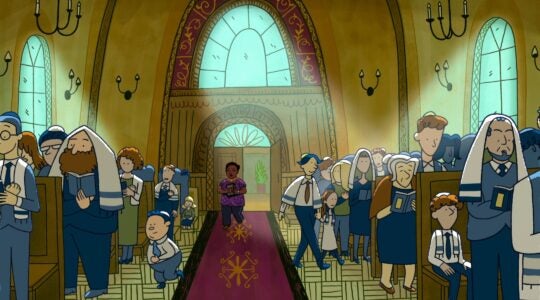The Torah explains that all of us were present to accept the Law at Mount Sinai (Deuteronomy 29:14). How can this be – if I was not physically present, let alone born, in what way was I present? And, barring a satisfying answer to that question, how can I be bound by a covenant that I didn’t make?
The Jewish mystical tradition holds that our souls were present, although our bodies weren’t. There were three million bodies and souls present at the time, but through reincarnation over time those souls have splintered off and been housed in many bodies. Thus, one may truly have a “soul mate” out there who is the other part of their fractured soul.
If one is not inclined to such a mystical view, one can see an aspirational message in this idea: Of course we were not there on that day, but we should strive to connect, existentially, to the spiritual moment as if we were there and to replicate the Sinaitic experience in our own lives.
For Sinai is not really just one historical moment. It is a continuing and recurring possibility that every soul can achieve unity with the beneficent Revealer. We all have the potential to stand there. This event is relived every time a committed and properly trained halakhic Jew attempts to grasp the Torah using his intellect:
“He does not search out transcendental, ecstatic paroxysms or frenzied experiences that whisper intonations of another world into his ears. He does not require any miracles or wonder in order to understand the Torah. He approaches the world of halacha with his mind and intellect just as cognitive man approaches the natural realm. And since he relies upon his intellect, he places his faith in it and does not suppress any of his psychic faculties in order to merge into some supernal existence. His own personal understanding can resolve the most difficult and complex problems. He pays no heed to any murmurings of [emotional] intuition or other types of mysterious presentiments.” (Halakhic Man, 79)
Another aspect to a deeper, timeless connection to the revelation at Sinai is nostalgia. There is a power to spiritual memory. Religious memory takes on its own inner life: To some extent, to remember an experience is to live it, to return home to a cherished, perhaps only imagined past. When you love someone, you can stand in solidarity with those connected with that person, even if the physical proximity is no longer there. I love my father’s mother, and I believe she loves me, but we never met; we are in a chain of solidarity and transcendental love, connected through her hopes, my living relatives’ memories of her and my personal story. When I rise to recite kaddish, the memorial prayer, I believe there is a connection.
Yet another perspective, perhaps a more important one, is that we the living are partners having and taking responsibility for the evolution of Torah. We have as much responsibility as our predecessors did, perhaps even more, as the great Revealer continues to retract from the world (according to the kabbalistic idea of tzimtzum). The Jewish interpretive enterprise began in the beginning and continues through time so that the moral and spiritual revelation can continue to be relevant and true in all eras and contexts: “What great praise it is for Israel, that as soon as they heard God’s word at Sinai, they began to interpret it.” (Midrash Mechilta)
A famous Talmudic passage (Menachot 29b) illustrates how Moshe was terrified upon prophesying that Rabbi Akiva would teach Jewish law that he himself didn’t understand. Moshe was comforted; however, when he heard Rabbi Akiva state that what he was teaching was also revealed to Moshe at Sinai: A revelatory process was put into place, producing new results to new generations that previous generations could never have fathomed and this enduring connection was solace to the initial recipient of the Torah.
Lastly, we ought to consider the legal notion of the “social contract.” We are bound by the social acceptance established by a founding generation, and we represent the generation that is the continuum of that agreement.
We may be most familiar with the social contract in its political sense. One school of thought, Absolutism, theorized that humans in their natural state were in a perpetual state of war, and that only the rule of a strong leader with unlimited power could establish the stability necessary for organized society to prosper (Thomas Hobbes’ Leviathan in the mid-17th century is the most well-known Absolutist work).
We can see this in the god-kings of ancient Mesopotamia, the Pharaohs of Egypt, through various modern tyrants (Louis XIV of France, Tsar Ivan IV “the Terrible” of Russia), many of whom encouraged the idea that a spiritual right was given them from on high to rule others without any check or balance on their power.
Another school of the social contract reacted against tyrants, from the Athenian democracy through the early Roman Republic to the later American and French revolutions. This concept, eventually outlined by John Locke in the late 17th century in his Second Treatise on Government and adapted most notably by Thomas Jefferson in the Declaration of Independence, presented a very different notion of a social contract. In this interpretation, people gathered in society for the mutual protection of rights; one person’s freedom existed so long as it did not infringe on the rights of another. In this social contract, absolute, concentrated power was an abomination.
Jean-Paul Sartre, the existentialist philosopher, experienced Absolutism at its most appalling depths during the Occupation in France during World War II. His great work, Being and Nothingness (published in 1943), reflects this rejection of this perverse social contract in which mass murder was normal and resistance to tyranny meant going against the norm. To Sartre, humans come into the consciousness of existence and can either follow the accepted modes of identity for one’s profession and class, which is merely the deceiving of oneself, or one can achieve “nothingness” by going outside of these deadening restrictions and take responsibility for one’s actions in the world. Sartre suggests that this choice of “nothingness” is a great existential achievement.
This compares in an interesting way with our Sinai covenant. The word for “those not present” (who really are present) at Sinai is “ainenu” (those who are not); with different meaning, the chassidic thinkers call this bitul-yesh. Those who were present (but who were not physically present) achieved the spiritual state of nothingness. As we view the social contract in its various forms and interpretations over the millennia, let us reflect on what this concept means to us, and be grateful for our continuing Sinai covenant – with our past selves, our families, and with God above.
Rabbi Dr. Shmuly Yanklowitz is the Executive Director of the Valley Beit Midrash, the Founder & President of Uri L’Tzedek, the Founder and CEO of The Shamayim V’Aretz Institute and the author of “Jewish Ethics & Social Justice: A Guide for the 21st Century.” Newsweek named Rav Shmuly one of the Top 50 rabbis in America.”
The New York Jewish Week brings you the stories behind the headlines, keeping you connected to Jewish life in New York. Help sustain the reporting you trust by donating today.





